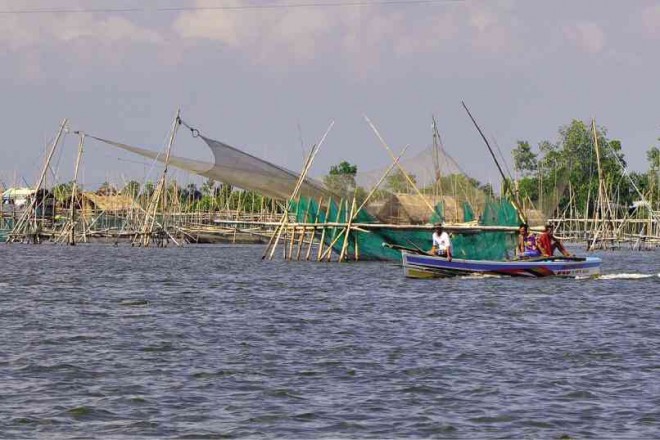‘Skylab,’ ‘batikwas,’ ‘surewin’ return to Dagupan

A BOAT passes by a “batikwas” (with green net) and a “skylab” (with dark-colored net), both indigenous fish traps, erected in the Calmay River in Dagupan City. These will soon be moved to locations identified by the city government. WILLIE LOMIBAO / Contributor
DAGUPAN CITY—With this city’s rivers already cleared of fish pens, it is now the marginal fisherfolk’s turn to enjoy their bounty.
And very soon, designated areas in the seven rivers traversing this coastal city of Pangasinan province will have “batikwas,” “skylab” and other indigenous fish traps, said Westly Rosario, chief of the National Integrated Fisheries Technology Development Center here.
A skylab consists of triangular bamboo stakes, while a batikwas is a net with its corners tied to four bamboo posts. The net is lowered at night and an incandescent bulb is used to attract fish to the net.
“We decided to highlight the indigenous fish traps. It’s only here in Dagupan City that I heard their names. To be honest, I cannot imagine why it was called skylab or ‘surewin.’ I did not even know how they spelled it,” Rosario said.
“Actually, by this time, a representative of each of these indigenous fishing structures should have been transferred to the areas where they should be located,” Rosario said.
Two weeks ago, Mayor Belen Fernandez launched Sa Ilog Ko, May Pagbabago, a livelihood program for this city’s marginal fisherfolk.
In June, Fernandez ordered the dismantling of all fish pens built in April and May this year by big-time “bangus” (milkfish) growers and capitalists in the city’s rivers.
Rosario said the livelihood program was conceived after a series of meetings between him, Fernandez and the City Agriculturist Office (CAO).
He said that to determine the location of the fish traps, a team from the CAO and his office mapped the city’s rivers to find out which areas are deep, shallow and “problematic” or areas not suitable to any fishing activity.
“Based on this map, the city came up with a policy on river use,” Rosario said.
He said most of the fish traps would be set up along river banks, while in shallow areas oyster structures would be built.
“We have to provide a good navigational lane [for passenger and fishing boats] and safe distances between structures. This way, they are organized,” Rosario said.
“If under the fishery ordinance the distance between structures is 10 meters, let’s make it 30 [meters] so that it will be wider,” he said.
Rosario said a team was studying how much each fisherman would make from each indigenous fish trap.
“For example, you gave an oyster raft to a family. Is it enough to feed a family of five? Or how many oyster rafts should you give so that the fisherman will make money?” Rosario said.
“They should make money. This is why I suggested that before charging them certain fees, we should monitor them first. If they are making money, then maybe after a year, we [can] charge them,” he said.
Rosario said he had also suggested that signage containing the names and descriptions of the indigenous fish traps, their cost and production, be attached to each structure for tourists to see when the city’s river cruise is revived.
The city’s river cruise, which was launched in May 2011, was stopped in June this year when Fernandez assumed as mayor.
But Rosario said the city government was planning to relaunch the river cruise after the completion of a dock in Barangay (village) Poblacion Oeste here.
“They also plan to have a live fish market there, where we can buy Bonuan bangus and other fish. There will also be a restaurant there,” he said.
The City Information Office said some 957 fishing structures were found in the city’s rivers during a mapping activity. The city government had dismantled about 154 fish pens. Gabriel Cardinoza, Inquirer Northern Luzon














